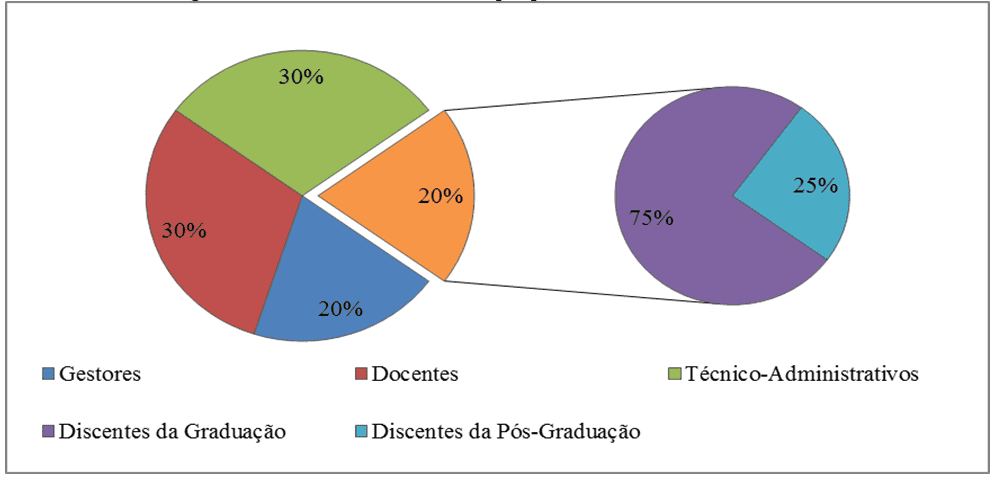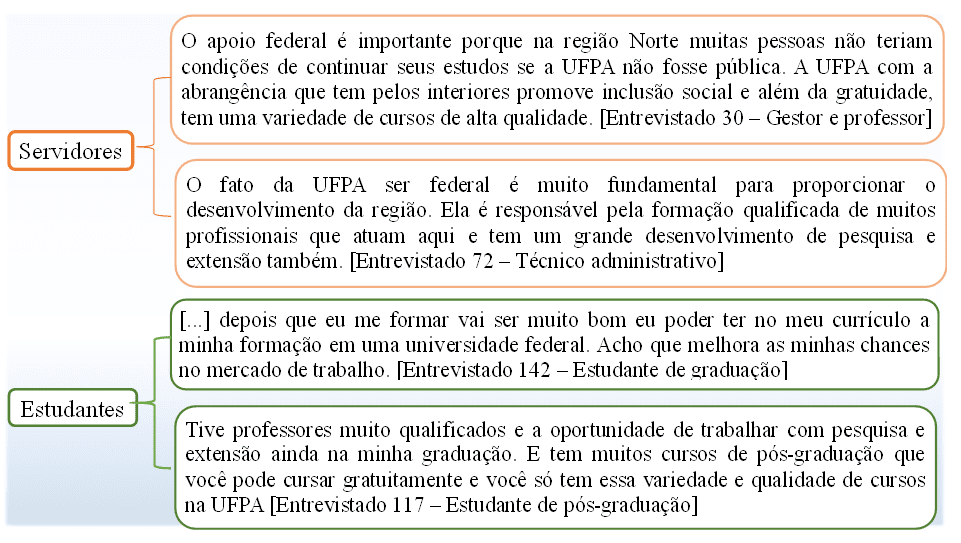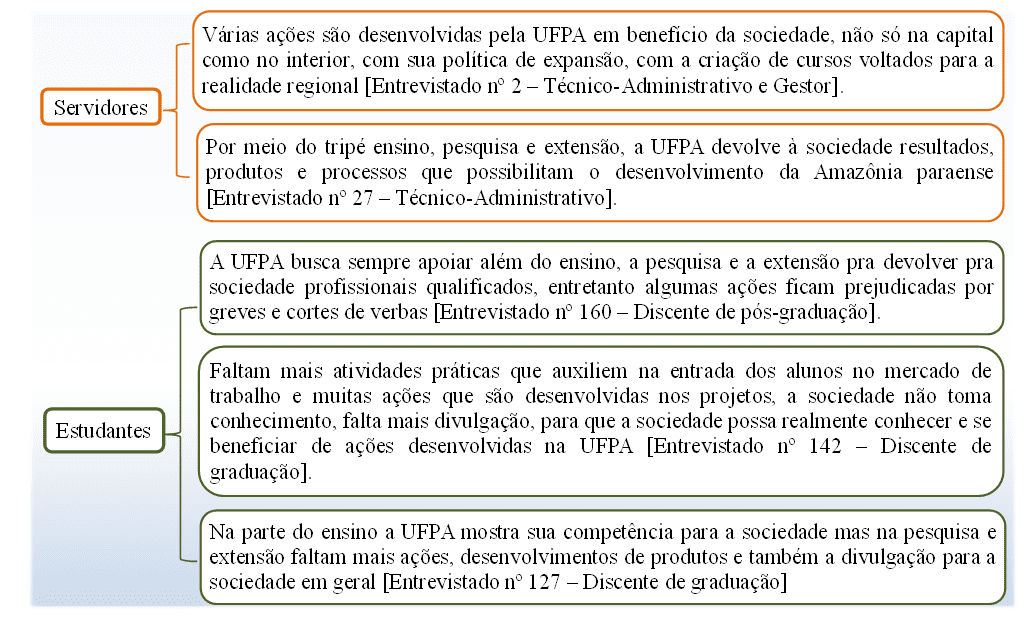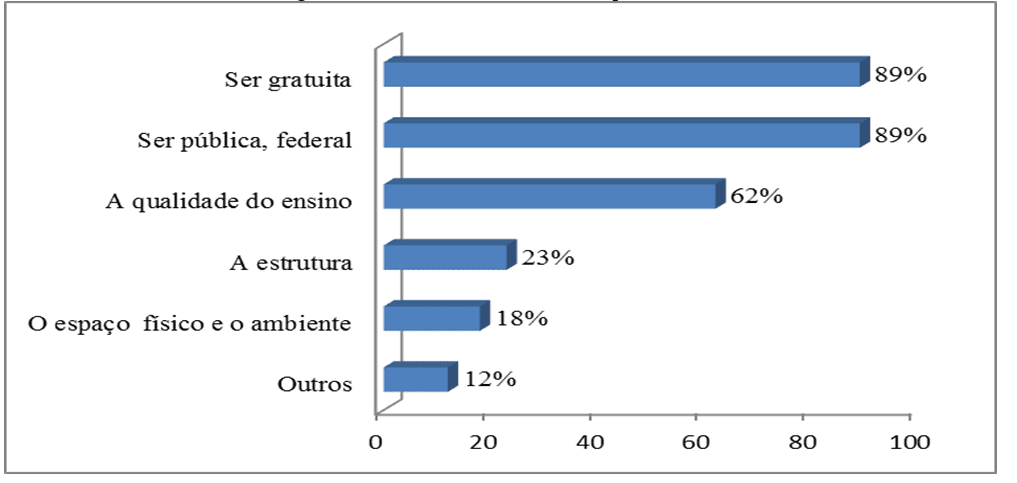ORIGINAL ARTICLE
COSTA, Sheila Maria Moreira [1], MATTOS, Carlos André Corrêa De [2]
COSTA, Sheila Maria Moreira. MATTOS, Carlos André Corrêa De. Analyzing internal stakeholders in a Higher Education Institution: The case at the Federal University of Pará. Revista Científica Multidisciplinar Núcleo do Conhecimento. Year 05, Ed. 06, Vol. 01, pp. 05-18. June 2020. ISSN: 2448-0959, Acess Link: https://www.nucleodoconhecimento.com.br/business-administration/analyzing-stakeholders
SUMMARY
Today’s organization managers cannot ignore the need to analyze and monitor the interest groups they depend on. These interest groups are your stakeholders. Stakeholder analysis, previously focused on the private sphere, is increasingly present in public institutions in view of their contribution to adding value through strategic management and the performance evaluation process. This article aims to analyze the presence of the Federal University of Pará (UFPA) as a strong brand in the Amazon region in the view of its internal stakeholders. For this, a qualitative and quantitative research was carried out at the headquarters campus in Belém, involving teachers, students and technical-administrative staff. The results of the research were obtained from semi-structured interviews, addressing questions about the view that these individuals have about the university in relation to their presence in society, as well as the efficiency and effectiveness of their actions and competencies. It was noticed that the UFPA has a good receptivity on the part of the interviewees, being their first choice with regard to training and employability. The interviewees also highlighted the relevance that the university has towards society as an institution that promotes science and social services. Thus, it is possible to conclude that UFPA contributes to regional performance and is recognized by its internal stakeholders.
Keywords: Institutions, stakeholders, UFPA.
1. INTRODUCTION
Higher education in Brazil is considered a strategic element for the preparation of a qualified cast of professionals who will be part of the labor market, and who have recognized skills and competencies. According to studies by Jorge, Oliveira and Ferreira (2016, p. 1,475), there is also, as part of this development strategy, a reverberant discourse that aims to benefit “social inclusion, through affirmative policies, student assistance, democratization of access, quota law, among others”.
In the reading of Lourenço e Mano (2014), massification and new perspectives on education and globalization “have pressed for a greater openness of their activity to society and to all those around them”. In this context, it is necessary to identify and analyze different stakeholders as a new administrative requirement that translates as a requirement of organizational performance.
Stakeholders in an organization were popularized by Freeman (1984) of stakeholders. This concept has evolved and definitions such as Bryson’s (2004) emerged, according to which stakeholders are the individuals, groups or organizations that should be taken into account by the leaders, managers and frontline staff of the organization in question. Johnson, Scholes and Whittington (2008) defined stakeholders as individuals or groups that depend on the organization to achieve their goals and on whom the organization also depends.
This approach gained space and developed a lot in the 1990s through the works of Goodpaster (1991), Clarkson (1995), Donaldson and Preston (1995), Mitchell, Agle and Wood (1997), Rowley (1997) and Frooman (1999) among others, becoming known as stakeholder theory.
Within higher education institutions, Jongbloed, Enders and Salerno (2008) presented stakeholder theory as a support tool to assist universities in classifying and determining the importance of their stakeholders. At the present time when universities are being charged for greater interaction with society (VOLPI, 1996), it is relevant to identify partners and select stakeholders, in order to mitigate the implications arising from governance agreements and accountability.
According to Kettunen (2014), the internal stakeholders of a higher education institution are students and servers. While, in general, the external ones are the partners, whose relationship with the institution usually takes place through research and development projects, and the customers who are the eventual buyers of some product or service that the institution can offer.
In fact, it is perceived that in a public university, in the case of this study, the servants (professors and technical-administrative), internal stakeholders, are responsible for the development of policies to serve society, both in teaching and in research and extension, in addition to other social services for inclusion as social and legal assistance that meet the demands of the community.
Thus, we sought to analyze the perception of stakeholders about the Federal University of Pará (UFPA), not only in relation to educational aspects, as the purpose of their services, but also in the social aspects that involve actions aimed at students and the community in general, mainly, policies to promote the professional qualification of employees who support their actions and competencies. Its scope, therefore, contemplates the academic, social and political context within the scope of its institutional performance.
2. STAKEHOLDERS OF A UNIVERSITY
The business concept of stakeholders has been expanded to non-profit organizations and from there to public organizations. Whereas many Higher Education Institutions (HEIs) operate in a similar manner to commercial enterprises (CHAPLEO; SIMMS, 2010), stakeholder theory began to be used by the administrators of these institutions.
On the other hand, public universities today need to demonstrate their relevance to society (MAINARDES et al., 2010), and then work more in extension and research projects, in order to reach certain sectors of society or even benefit society as a whole. To achieve these objectives, public universities have begun to establish partnerships with the external sector, thus receiving resources in some cases and as a consequence needs to achieve efficiency standards and perform accountability.
The Sakeholders Theory began to be used in institutions, initially aiming at identifying stakeholders after their demands and how to meet them. According to Mainardes et al. (2010), “identifying the stakeholders involved with the HEI is a fundamental step in establishing the competitive advantages of the educational institution, as well as identifying the needs of these stakeholders and offering ways to meet them.”
The various attempts to classify stakeholders made in the business context were used or adapted to the situation of public institutions. Mainardes et al. (2013) explains that the stakeholders of a university are numerous and of various types and there are several attempts in the literature to categorize them. In general, the studies highlight as ies stakeholders the academic community (students, professors, technicians, managers), the government, funding agencies, society in general (history of stakeholders in the HEIs in MAINARDES et al., 2013).
Among the classifications successfully used, duderstadt (2000), expanded later by Jongbloed; Enders and Salerno (2008) and Matlay (2009), which classifies hei stakeholders as: Interns, which covers students, teachers, technicians and managers; and external, covering former students, government and professional entities, funding agencies, foundations, community in general.
More specifically, this study focuses on internal stakeholders, namely the academic community, considering that students play a fundamental role in the development of an HEI, given that their success in the professional career reflects in the HEI they studied (JONGBLOED; ENDERS; SALERNO, 2008); and employees (teachers, managers and technicians) represent the most important force in the maintenance of HEIs (BOWEN; SHAPIRO, 1998).
According to Jongbloed, Enders and Salerno (2008) the HEIs need to maintain a commitment to their stakeholders as a way of understanding how they are perceiving the services provided and how these services can be improved. This constitutes the objective of the present study.
3. MATERIAL AND METHODS
3.1 SEARCH
The analysis of internal stakeholders of a public university will be developed from a case study. It is considered the appropriate method since it is intended to study the phenomenon in the context and within the limits of the institution (YIN, 2003). Thus, the case study unit was the Federal University of Pará, Campus Belém.
For the study, 200 people working or studying at the Belém Campus of UFPA, which represents the institution’s headquarters, were selected. The sample sought the representativeness of the main categories that pass through the university campus according to the following distribution: 40 managers, 60 professors, 60 technical-administrative, 30 undergraduate students and 10 graduate students at UFPA in 2017.
For the selection of UFPA servers (managers, teachers and technical-administrative), the inclusion criterion was the greater involvement of these in their respective functional categories and the greater experience in the activities developed. In the selection of undergraduate students, the criterion of participation in the study was to be in the final phase of their graduation, because it was understood that they would have a broader view of the institution. And for graduate students, the criterion was knowledge about research and scientific production.
The research was quantitative-qualitative, with data collection done through semi-structured interviews with the subjects investigated, since the case study is shown as a possibility to achieve not only an approximation with what one wishes to know and study, but also to acquire knowledge about it and its relations with the environment , starting from the reality in which it is inserted.
In compliance with Resolution 466/12/12 of the National Health Council on Guidelines and Regulatory Norms of research involving human beings, data collection met the ethical principles of respect for the rights and dignity of the people surveyed. Participants were informed of the content of the research and provided written consent and were guaranteed anonymity throughout the analysis process.
For quantitative analysis, the answers of the respondents were inserted into data sheets in excel software (Office version 2010 program). For the categorical variables, the tabular abstract was used by means of absolute and percentage frequencies, represented by graphic figures.
The qualitative analysis will be presented in two dimensions of the interview (servers and students), will be digitized and the information will be treated using the Content Analysis technique proposed by Bardin (2011), this type of analysis was already used since the first attempts of humanity to interpret the sacred books, having been systematized as a method only in the 20’s, by Leavell. For which it defines a set of procedures for analyzing communications through systematic and objective methods of characterizing the content of messages in three stages: (1) presented as pre-analysis (consists of floating reading of all transcribed material); (2) stage of exploration of the material for the records of initial categories and last, (3) the stage defined as inference and interpretation, where the initial categories will be grouped into intermediate and final thematic categories.
3.2 THE LOCUS OF RESEARCH: THE FEDERAL UNIVERSITY OF PARÁ
The Federal University of Pará (UFPA), founded in 1957, is one of the largest federal public institutions of higher education and one of the largest multicampi universities in Brazil, where about 60,000 people, including teachers, technical-administrative staff and students, are developed, distributed in several municipalities, whose headquarters are located in Belém, capital of the state of Pará.
The physical structure of UFPA is composed of the following units and bodies: 12 campuses, 93 poles, 12 institutes, 06 nuclei, 02 hospitals, 01 application school, 01 theater and 01 museum. It is considered the largest university in the Amazon, both in extension and in a contingent of human resources, amount of projects and research aimed at the development of public higher education. This university has its organization in the form of an authority, being linked to the Ministry of Education (MEC), whose fundamental principle is based on the integration of the three functions: teaching, research and extension
The headquarters campus, in Belém, called University City Professor José da Silveira Netto, consists of 05 sectors: Basic, Professional I, Professional II, Professional III and Professional IV, and outside the area of this campus, located in the center of the capital, are the Institute of Art Sciences, the Faculty of Medicine, the Tropical Medicine Center, the Museum, the School of Music , the Dance School and the Theatre and the Application School.
With regard to the campuses of the interior, UFPA is distributed in a wide extension of the state, with the purpose of bringing education and training to students from Pará in all its regions. For this, UFPA is present in several municipalities through the following campuses: Abaetetuba, Altamira, Bragança, Capanema, Castanhal, Marajó-Breves, Marajó-Soure, Salinópolis, Tocantins-Cametá and Tucuruí (UFPA, 2015).
At UFPA there are 76 undergraduate colleges in the various areas of science and technology and several lato sensu graduate programs (specialization), developed by the institutes. In relation to stricto sensu graduate studies, it has several master’s and doctoral programs, linked to the institutes, and the master’s degree is divided into academic, with 57 courses, and professional, with 16, and the doctorate has 35couples. All these courses are approved by Capes and CNPq, with a quality seal.
4. Results
The total sample consisted of a total of 200 interviewees, as research subjects and considered the internal stakeholders of UFPA, divided into five categories: managers (40), professors (60), technical-administrative (60) and students (40) undergraduate and graduate graduate students according to the distribution shown in Figure 1
Figure 1. Distribution of the research sample with ufpa servers.
For the analysis of the data obtained from the interviews with the servers and students, a content analysis of the results was initially performed, performing systematization, categorization and exploratory analysis.
In the initial question, the servers and students were asked if they considered ufpa important in the educational scenario because it belongs to the federal sphere. Both the employees and the students responded positively to this question, justifying in their statements that the support of the Union is important for UFPA to continue training professionals and producing science, technology and culture. Figure 2 highlights the opinion of some servers and students, which highlighted the issues of qualified education that students receive, social inclusion, variety of courses and the development of research and extension.
Figure 2. Comments from the servers and students about the importance of UFPA belonging to the federal sphere.
Asked if the services (teaching, research and extension) and the production (scientific, technological and cultural) of UFPA demonstrate their competence before society, the employees expressed themselves in a positive way: they emphasized that the actions developed by UFPA result from the work of competencies (managers and collaborators), and this will impact on the services provided and production demonstrating to society that ufpa is working on the three axes : teaching, research and extension.
The students, in turn, despite agreeing that UFPA develops activities in the three axes, showing their competence for society, are concerned about funding cuts, also reporting that many students do not have the opportunity to participate in teaching and extension projects. On this subject, an interviewed manager (Interviewee 65) reported that the Graduation Regulations (Resolution n. 4.399 CONSEPE of 14.05.2013) provides that the Pedagogical Projects of the UFPA Courses should include research and/or extension activities as components of the academic course of undergraduate courses, establishing a minimum of 10% of the course workload dedicated to extension activities for undergraduate payment. Figure 3 presents some comments from servers and students.
Figure 3. Comments from the servers and students about how the services (teaching, research and extension) and the production (scientific, technological and cultural) of UFPA demonstrate their competence before society.
In general, according to the view of the servers, both services through undergraduate and graduate education, as well as research with large development projects of the Amazon region in all areas of knowledge, and programs and extension projects to strengthen the relationship with communities, as well as their capacity for scientific, technological and cultural production are evident in UFPA , which adopts the multicampi model of development of its actions, no longer being able to limit its scope for development, demonstrating its competence in actions and mission to carry forward the commitment to train the competent man and professional to act in society.
In this sense, the understanding of the servants in this regard is supported by the arguments of Bampi and Diel (2015), which emphasize the multicampi model of the university as one that currently maintains better relations with society, since it encompasses the entire context of its scope to bring knowledge and development through its competencies to train new professionals more competent and involved with political and social problems. This is the case of UFPA, which aims to reach people in the most distant spaces of the Amazon, in their own communities and with them to discuss and build new knowledge and knowledge.
It is noteworthy, however, that the students’ view tends to be a little more critical considering that these are the central stakeholders of the HEIs and recipients of knowledge, are the most sensitive to the problems that the institution may present since this will directly impact their training.
In an attempt to understand a little more about the students, they were asked what led him to choose the UFPA to carry out his studies. The question can have multiple answers and Figure 4 presents the results.
Figure 4. Reason to choose UFPA to study
Being federal public and being free were the categories of greater preference of students, because it is a traditional university in higher education, which stimulates much more young people from Pará, especially those from middle and lower classes who see in UFPA the opportunity to attend a college and the support they receive from the institution and according to the vast majority of these gratuity is relevant point , not paying attention to the quality of teaching. On the other hand, offering quality of education was the choice of 62% of students, because, according to them, the federality of the university gives greater support to university students, as explained by one interviewee:
UFPA qualitatively prepares students for the market as competent professionals, besides being a public institution of higher education recognized nationally and internationally, which also qualifies and accredits the graduates who come from it to occupy positions in society. In my case, I did here the graduation in the area of biological, I am completed the master’s degree in the same area, I already work in the profession and I feel competent in the function I exercise. I believe that, even if there are some difficulties, precisely because it is a public university with a lack of resources, it is the student who should chase. UFPA has good laboratories, a large bibliographic collection and, above all, has excellent professors at the doctoral level that include students with many knowledge and techniques necessary for the profession (Interviewee no. 165 – Graduate student).
The situation of UFPA is no different from other IFES globally. There are several problems and challenges that institutions need to face in higher education (BENEKE, 2011, p. 37). Kotecha (2003) already stated that the root of these problems lies in the origins of some universities, which have established themselves as conservative institutions, by nature, taking time to adapt to change. However, when the institution manages to arouse the interest of its target audience (internal stakeholders), it achieves leadership and prominence (GUPTA; SINGH, 2010).
5. Conclusions
UFPA, within its program of resizing and support to the servants and encouraging the qualification of these, promotes more incentive to those who still need better training and organizational behavior, to form a consciousness and responsibility stimulated by emotional intelligence that promotes good interpersonal relationships, whose absence or lack harms the image that this institution has sought to build and present to its stakeholders.
Understanding and prioritizing its internal stakeholders is of paramount importance to THE. Because it is from the knowledge of their internal public that the HEIs can establish whether teaching, research and extension are really meeting the demands of their stakeholders, whether the expected goals are being met and whether institutional problems are being adequately solved in their view.
The importance of stakeholders for HEI increases when one takes into account budgets that are constantly being reduced or cut requiring the creation of strategies for the capture of external resources for care. And to present the appropriate profile to be seen by external stakeholders, nothing better than doing a good job with internal stakeholders, as these will serve as a reference and part of them will enter the network of external stakeholders in the future.
REFERENCES
BAMPI, A. C.; DIEL, J. O. O modelo multicampi de universidade e suas relações com a sociedade. In: XIII Coloquio de Gestión Universitaria en Américas. Disponível em: https://repositorio.ufsc.br/bitstream/handle/123456789/114920/2013281. Acesso em 01/11/2015.
BARDIN, L. Análise de conteúdo. São Paulo: Edições 70. 2011.
BENEKE, J. H. Marketing the institution to prospective students – a review of brand management in higher education. International Journal of Business and Management, 6(1), 29-44. 2011.
BOWEN, W.G.; SHAPIRO, H. T. Universities and their leadership. Princeton University Press (pp. 33-37). 1998,
BRYSON, J. M. What to do when stakeholders matter: stakeholder identification and analysis techniques. Public Management Review 6 (1) p.21-53. 2004.
CHAPLEO, C.; SIMMS, C. Stakeholder analysis in higher education. Perspectives: Policy and Practice in Higher Education, 14(1), 12–20. 2010.
CLARKSON, M. A stakeholder framework for analyzing and evaluating corporate social performance. Academy of Management Review, 20(1): 92–117. 1995.
DONALDSON, T.; PRESTON, L. The stakeholder theory of the corporation: concepts, evidence and implications. Academy of Management Review, 20(1), 65-91. 1995.
DUDERSTADT, J. Fire, ready, aim: university-decision making during an era of rapid change. In: The Glion Colloquium II, La Jolla, California. 2000.
FREEMAN, R. E. Strategic Management: A Stakeholder Approach. Cambridge: Cambridge University Press.1984.
FROOMAN, J. Stakeholders influence strategies. Academy of Management Review, 24(2), 191-205. 1999.
GOODPASTOR K. Business ethics and stakeholder analysis. Business Ethics Quarterly, 1: 53–71. 1991.
GUPTA, M.; SINGH, P. B. Marketing & branding higher education: issues and challenges. Review of Business Research, 10(1), 46-53. 2010.
JOHNSON, G.; SCHOLES, K.; WHITTINGTON, R. Exploring corporate strategy: text & cases (Vol.8). Harlow: Pearson Education. 2008.
JONGBLOED, B.; ENDERS, J.; SALERNO, C. Higher education and its communities: interconnections, interdependencies and research agenda. Higher Education, 56, 303-324. 2008.
JORGE, S. A. V.; OLIVEIRA, J. F.; FERREIRA, S. O papel social das universidades federais frente a política de desenvolvimento regional: os casos da UNIVASF, UFRB e UFERS. In: XXIV Seminário Nacional UNIVERSITAS/BR. Maringá-PR. Anais do XXIV Seminário Nacional UNIVERSITAS/BR. 2016. Disponível em: http://www.ppe.uem.br/xxivuniversitas/anais/trabalhos/e_6/6-013.pdf. Acesso em 12/12/2019.
KETTUNEN, J. The stakeholder map in higher education, Society, Education and Psychology, Vol. 78, 34-38. 2014.
KOTECHA, P. Branding, mergers, and the future of South African higher education. South African Universities Vice-Chancellors Association, Pretoria. 2003.
LOURENÇO, R. T.; MANO, M.). Os Stakeholders e as Instituições de Ensino Superior. In: 4º Conferencia FORGES (pp. 1–16). Luanda e Lubango, Angola. 2014. Disponível em: https://pdfs.semanticscholar.org/0f0d/0189e8315babd2675006e765d0308d46788a.pdf. Acesso em: 9/12/2019.
MAINARDES, E. W, ALVES, H.; RAPOSO, M. Identifying Stakeholders in a Portuguese university: A case study. Revista de Educación, 362, 429–457. 2013.
MAINARDES, E. W.; ALVES, H.; RAPOSO, M. An exploratory research on the stakeholders of a university. Journal of Management and Strategy, 1 (1), 76. 2010.
MATLAY, H. Entrepreneurship education in the U.K.: a critical analysis of stakeholder involvement and expectations. Journal of small business and enterprise development, 16(2), 355-368. 2009.
MITCHELL, R.; AGLE, B.; WOOD, D. Toward a theory of stakeholder identification and salience: defining the principle of who and what really counts. Academy of Management Review, 22(4), 853-858. 1997.
ROWLEY, T. Moving beyond dyadic ties: a network theory of stakeholder influences. Academy of Management Review, 22(4), 887-910. 1997.
VOLPI, M. T. A universidade e sua responsabilidade social. Porto Alegre: EDIPUCRS, 1996.
YIN R. K. Case Study Research: Design and Methods, 3rd edition. Sage Publications, Thousand Oaks, CA. 2003.
[1] Economist. Master in Business Direction and Administration – Faculdad de Ciencias Empresariales.
[2] Administrator. Doctor of Agrarian Sciences.
Sent: March, 2020.
Approved: June, 2020.


















